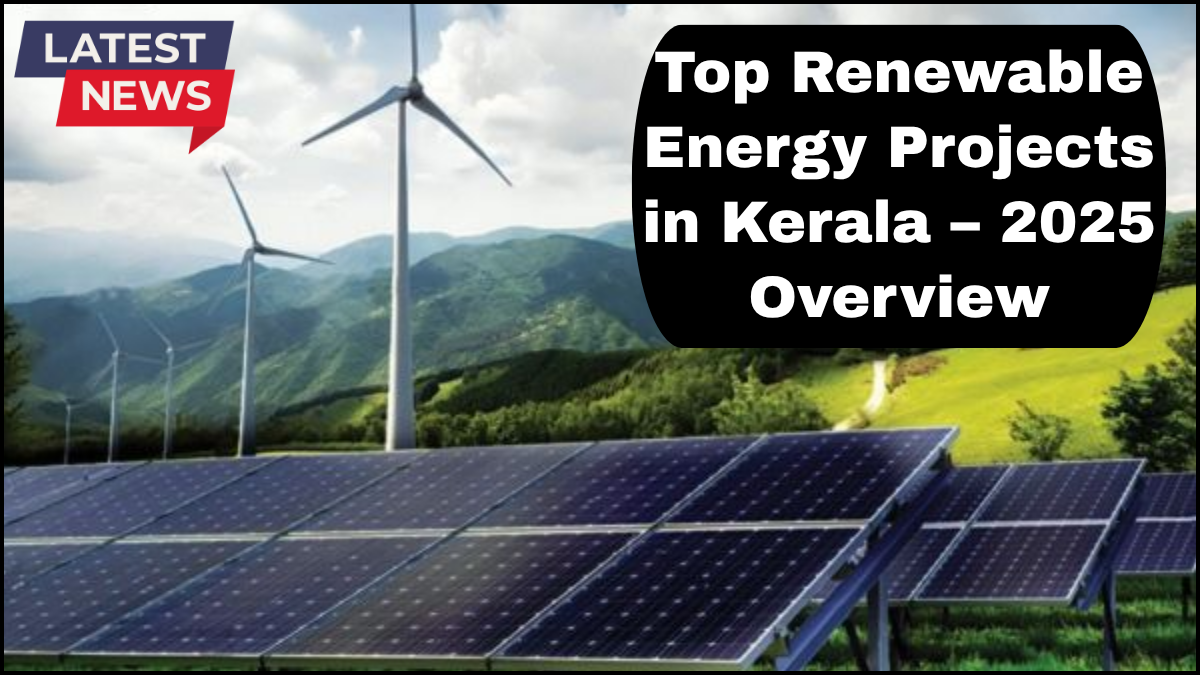Kerala is accelerating its transition to sustainable energy, with 2025 poised to be a milestone year. The state is rapidly expanding its portfolio of renewable energy projects, focusing on solar and hydro power to reduce dependence on fossil fuels and meet its ambitious climate targets. Here’s a detailed overview of the top Kerala Renewable Energy Projects that are making a difference in 2025.

1. Cochin International Airport Solar Expansion Project
Cochin International Airport (CIAL), the world’s first airport fully powered by solar energy, has scaled up its infrastructure in 2025. The airport now hosts a 40 MW solar plant, up from 30 MW in previous years. Spread over 130 acres, this solar farm now powers not just the airport but also contributes excess electricity to the state grid.
-
Why it matters: This project demonstrates the feasibility of large-scale solar integration in commercial infrastructure.
-
Tech update: Incorporation of AI-based energy management systems has improved energy efficiency by 15%.
2. Idukki Hydro Modernization Project
Kerala’s hydro power backbone—the Idukki Hydroelectric Project—has received a major technological overhaul in 2025. Modern turbines with higher conversion efficiency and AI-driven water flow monitoring systems have been installed, boosting output by 20%.
-
Capacity: 780 MW (post-upgrade)
-
Impact: Helps stabilize Kerala’s grid during monsoons and reduce reliance on diesel generators in rural areas.
This initiative reinforces the significance of hydro power in Kerala’s clean energy mix and extends the lifespan of legacy infrastructure through modernization.
3. ANERT Rooftop Solar Scheme Expansion
The Agency for Non-conventional Energy and Rural Technology (ANERT) has widened the scope of its rooftop solar scheme in 2025. With subsidies now covering 60% of installation costs for households and SMEs, the project has seen adoption across over 200,000 homes statewide.
-
Total capacity added in 2025: 500 MW
-
New feature: Net metering has been replaced with net billing for higher returns to consumers.
This initiative is a key driver behind Kerala’s push for decentralized solar energy production.
4. Floating Solar Plant on Banasura Sagar Dam
In a bold step toward innovative energy solutions, a 75 MW floating solar plant is now operational on Banasura Sagar Dam in Wayanad. Launched in early 2025, this project minimizes land usage while maximizing output.
-
Technology used: PV panels mounted on high-density polyethylene floats
-
Advantages: Reduced evaporation loss, better panel efficiency due to water cooling
This project is seen as a benchmark for combining solar and water resources efficiently, adding depth to Kerala’s renewable energy strategy.
5. Energy Storage & Smart Grid Pilot in Trivandrum
One of the critical challenges in renewable integration is storage. In 2025, Kerala launched a pilot smart grid in Trivandrum with 100 MWh battery storage capabilities. Designed to manage energy flow intelligently, it ensures consistent supply even during solar or hydro downtimes.
-
Key feature: AI-driven demand forecasting
-
Purpose: To balance peak demand and maintain voltage stability in urban centers
This pilot is expected to set the stage for wider deployment across the state by 2027.
6. Community Microgrids in Tribal Areas
Under the Kerala Renewable Energy Policy 2025, several community microgrids have been established in remote tribal villages in Attappady and Wayanad. These hybrid systems combine solar & hydro power to provide 24×7 electricity access.
-
System type: Standalone microgrids with battery backup
-
Outcomes: Improved education, healthcare access, and digital inclusion
These microgrids are small in scale but transformative in impact.
Kerala’s Renewable Energy Strategy: The Bigger Picture
Kerala’s energy roadmap focuses on decentralization, innovation, and resilience. The 2025 strategy emphasizes:
-
Increasing renewable energy share to 50% of the state’s total energy mix
-
Strengthening infrastructure for solar and hydro systems
-
Encouraging public-private partnerships and international funding
With support from central schemes like the PM-KUSUM and state incentives, Kerala is setting a model for sustainable development rooted in local resources and community participation.
FAQs
What is the total renewable energy capacity of Kerala in 2025?
As of mid-2025, Kerala’s renewable energy capacity stands at approximately 4,500 MW, with solar and hydro contributing the majority.
Why is hydro power important for Kerala?
Hydro power is a stable, reliable energy source for Kerala due to the state’s heavy rainfall and terrain. It complements solar power by providing energy during non-sunny hours.
What role does ANERT play in Kerala’s energy plans?
ANERT leads policy execution and grassroots initiatives for renewable energy in Kerala, especially in rooftop solar, bioenergy, and awareness programs.
How can households participate in solar projects in Kerala?
Households can apply for rooftop solar installations under ANERT’s subsidy schemes. In 2025, the state covers up to 60% of the installation cost.
Are there any upcoming projects beyond 2025?
Yes, plans are underway for offshore wind studies, expansion of floating solar farms, and integration of green hydrogen pilot programs from 2026 onward.
click here to learn more
